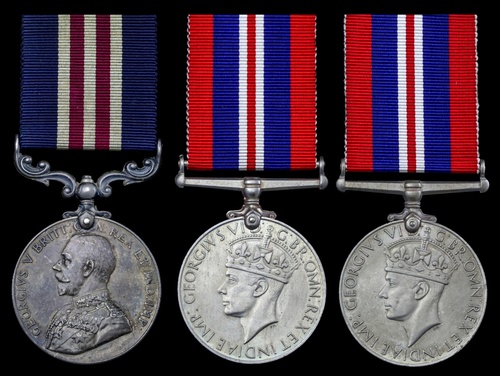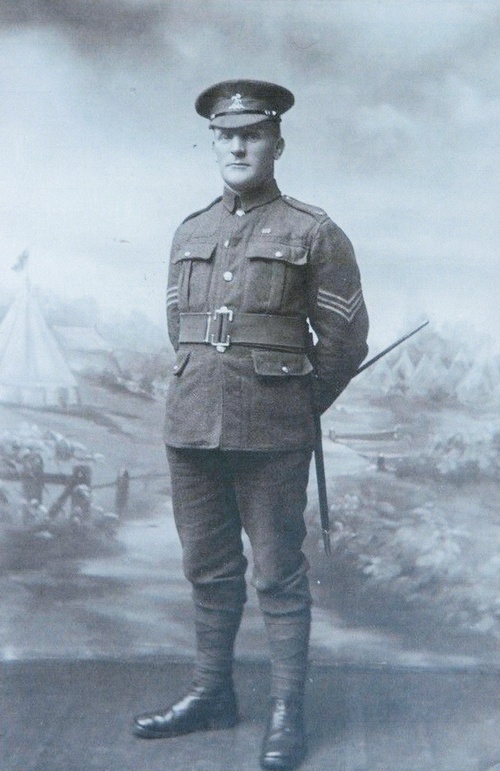Auction: 19003 - Orders, Decorations and Medals
Lot: 353
Family group:
A fine Great War M.M. awarded to Sergeant E. C. Page, Queen’s Own (Royal West Kent) Regiment, who was five times wounded during the Great War, being decorated for leadership and an ‘absolute contempt of danger’ during the Hundred Days Offensive
Military Medal, G.V.R. (G-485 Sjt. E. C. Page. 1/R.W. Kent. R.), light contact marks, very fine
M.M. London Gazette 11 February 1919. The citation states:
‘Acting as Sergeant-Major of his Company, after his Company Commander was wounded and the objective was taken, he assisted in reorganising the Company. Throughout the whole operation, he showed great coolness and the greatest bravery under heavy machine-gun fire. This N.C.O. had been wounded five times during the Campaign and had always shown great coolness and absolute contempt for danger.’
Ernest Charles Page was born on 9 August 1895 at Swanley, near Sevenoaks, Kent. A grocer’s assistant by trade, Page attested at Woolwich for the Queen’s Own (Royal West Kent) Regiment on 29 August 1914, being attached to the 6th Battalion on 2 September 1914. Landing with his Regiment at Boulogne on 1 June 1915, he fought at the Battle of Loos - where the British and French tried to break through German defences in Artois and Champagne and restore a war of movement - and was likely witness to the first use of poison gas by the British Army on 25 September 1915. The attempt proved a disaster, the chlorine - codenamed Red Star - lingering in no-man’s land and blowing back on the British trenches in places (Chemical Warfare in World War I: The American Experience 1917-18, refers).
Posted to ‘D’ Company on 5 November 1915, Page transferred to the 3rd Battalion on 30 December 1915 and the 1st Battalion on 19 May 1916, being promoted Lance-Corporal on 18 September 1916. The Battalion were heavily engaged during the Attacks on High Wood, The Battle of Guillemont, the Battle of Flers-Courcelette, the Battle of Morval and the Battle of Le Transloy. From October 1916 to March 1917 the men were stationed in Festubert, before later transferring to Italy and taking up positions along the River Piave. Recalled to the Western Front in order to stem the German Spring Offensive, the Battalion fought doggedly during the Battle of the Lys from 7-29 April, 1918, attempting to maintain possession of the ruins of Ypres and hold back the German push towards the Channel ports. Promoted Corporal on 22 May 1917 and Acting Sergeant on 3 November 1917, Page was decorated for bravery in the field at Bapaume and Gouzeaucourt.
Battalion casualties were heavy, three officers being killed and six wounded, 59 other ranks killed and 118 wounded, and a further 10 men slightly wounded who remained on duty. In addition, 37 men were missing at the roll-call, of whom 35 later turned up at hospital wounded, having failed the pass through the Regimental Air Post (The Battalion History, Invicta, refers); sold with copied M.I.C. and research, Royal West Kent cap badge and shoulder titles (2), and miniature dress 1914-15 Star and Victory Medal.
Leading Aircraftman R. H. Page, Royal Air Force
War Medal 1939-45, unnamed as issued, in O.H.M.S. transmission box addressed to ‘R. H. Page, Esq., 1 Orchard Avenue, Dartford, Kent’, with medal entitlement certificate and slip ‘1618577 LAC’, good very fine
Sold with contemporary R.A.F. brass cap badge and small silver and enamel ‘Wings’ sweetheart brooch.
Mrs. I. L. Page, formely Froud, Auxiliary Territorial Service, Royal Signals
War Medal 1939-45, unamed as issued, in O.H.M.S. transmission box, addressed to ‘Mrs R. N. (sic) Page, 1, Orchard Avenue, Dartford, Kent’, with medal entitlement certificate, good very fine (3)
Ivy Lilian Froud served with the A.T.S., Royal Signals, in support of the work of Bletchley Park during the Second World War. Posted to Kedleston Hall from October 1942-November 1944, and Forest Moor from November 1944-May 1945, she was likely involved in tracking enemy radio networks up and down the dial, carefully logging every letter or figure. These messages were then sent back to ‘Station X’ at Bletchley Park where they were deciphered, translated and fitted together like a giant jigsaw puzzle.
In June 2009 the Daily Telegraph announced that surviving staff who worked in such secret conditions would be eligible for a commemorative badge. David Miliband, Foreign Secretary, said veterans of Bletchley Park and its outlying stations would be awarded the badge as a ‘fitting recognition of their loyal service’.
Sold with copied research confirming service; a copy of Bletchley Park, Home of the Codebreakers - bearing the signatures of 2 Forest Moor outstation workers - and a copy of Spymaster, The Secret life of Kendrick by Helen Fry; the recipient’s ‘Bletchley Park Outstation Veteran’ commemorative badge in box of issue, A.T.S. shoulder title and Royal Corps of Signals cap badge.
Subject to 20% VAT on Buyer’s Premium. For more information please view Terms and Conditions for Buyers.
Estimate
£400 to £500
Starting price
£280









